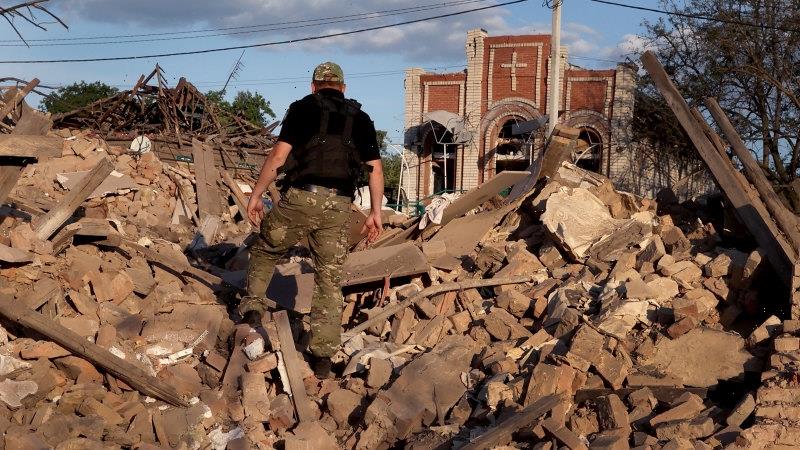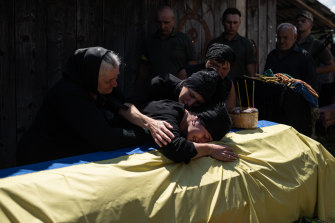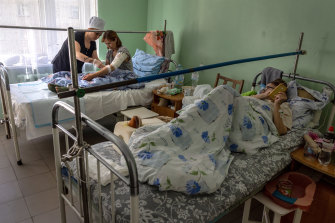After ‘victory’ in Luhansk, what next for Russia?
Since Russia began its invasion of Ukraine, we have witnessed from afar the shifting fortunes of war: advances and retreats, leadership failures and brilliant courage, logistic challenges, and widespread information operations.
Initial pessimism about Ukraine’s chances became extreme optimism. In the last several weeks, pessimism has again returned, particularly among those who seek to divine strategic outcomes from single tactical events.
Maryna Hrynchuk cries over her husband’s coffin. He was killed in the Luhansk region.Credit:Getty Images
Evidently, Russian forces have now completed their conquest of the Luhansk region. They have however only partially succeeded in achieving their operational objectives here: they have almost met Putin’s goal of capturing the Donbas; and, while they drew the Ukrainians into a battle of attrition, they have not destroyed the Ukrainian army in the field, not their steel will.
The Ukrainians, having persevered in the face of Russian advantages in artillery and air power in this part of the country, were able to undertake retrograde operations to preserve their army in the east. They have ensured the Russian forces bled for every metre of territory gained in Luhansk. But, it has also come at a high cost to Ukraine’s soldiers.
What might be the next move in the revised Russian strategy for Ukraine?
First, Russia will leverage this “victory” for its strategic influence campaign. Putin, having already apparently declared victory in the past 24 hours, will want to communicate this as a success to his domestic audience. This is mainly to reassure Russians about the trajectory of the war. But Putin will also be keen to use it to invigorate lagging Russian military recruiting campaigns.
Globally, Russia will portray these developments as a sign that the tide of the war has turned (it hasn’t). This Russian messaging will seek to convey to wavering nations and politicians in the West (yes, there are still a few) that supporting Ukraine is only delaying the inevitable.
Militarily, Russia has options for its next operational objectives. The Russian army leadership might have liked to assume a defensive posture to rest, resupply and regenerate forces in the east. This, however, risks wasting the tactical momentum – and momentum in Russian strategic information operations.
The Russians, always ruthless in their battlefield calculations, are likely to have made the assessment that no matter how exhausted Russian troops and logistic systems are, the Ukrainians are probably more exhausted. War is about relative advantages, and exploiting them. The Russian high command, prodded on by Putin, is likely to have come to the conclusion that despite the high costs for Russian soldiers continuing the offensive in the east, they can bear these costs more than the Ukrainians.
And, the majority of Russian forces engaged and bloodied in the east have been proxies and mercenaries. These are of little consequence to Putin. But they have bought him time to cobble together Russian army reserve forces for action in the next phase of this campaign.
The Russian army will therefore seek to continue advancing to secure the entire Donetsk region. To do so, they will maintain their approach taken throughout the eastern campaign; to advance behind their extensive artillery and rocket fires, seek the envelopment and destruction of Ukrainian forces, while continuing their strategic missile strikes across Ukraine to interdict logistic supply lines to the Donbas.
But the Russians face challenges elsewhere that will impact this.
The Russians are also under pressure in the south. In Kherson, Ukraine is continuing to seize back territory through a series of rolling counter-attacks. This conflict in the south is the more decisive front in this war. Possession of Ukraine’s territory in the south permits Russia to economically strangle Ukraine. As such, the Russians cannot allow too much Ukrainian progress here. The challenge in the south is magnified for the Russians by the Ukrainian resistance activities. Over the weekend, another Russian train was derailed in the south and there has been a campaign targeting Russian soldiers and collaborators.
A nurse checks the wounds of Ponomareva Natalia Sergiivna three days after her family’s home was shelled by Russian forces in their frontline village of Vysokopilla in the Kherson region of southern Ukraine.Credit:Getty
So, in the wake of any Luhansk success, and despite Putin’s orders to continue, Russia may have no choice but to rebalance its forces between the east and the south. This – and stout Ukrainian defences in the east – will influence their desire and ability to seize the entire Donbas region.
The Ukrainian government and military high command also have an east versus south challenge. How much military capability can it invest in defending the east, and how much should it deploy in its offensive activities in the south? This is a tough balancing act in both the political and military arenas. The demands to defend all of their territory will have a major impact. But so too will the level of Western military, intelligence and economic aid.
While tactical momentum in the east of Ukraine may be with the Russians, this momentum has been enormously expensive in both lives and ammunition. It has destroyed whole cities and resulted in relatively small amounts of seized territory. And if Western support – and the nerve of Western leaders – holds over the coming months, the longer-term prospects still favour Ukraine. And this means that while Australia so far has been the largest non-NATO provider of aid to Ukraine, the government will probably need to commit additional military and economic aid in the near future.
In the short term though, the Ukrainians in the east face a renewed Russian onslaught. It is likely to be every bit as brutal as that we have seen in the past two months.
But Ukrainians have shown in this war how effective a defensive strategy can be if it integrates modern sensors, precision munitions, appropriate levels of reinforcements, flexibility and good leadership. They will need a full measure of all these in the weeks ahead.
Get a note directly from our foreign correspondents on what’s making headlines around the world. Sign up for the weekly What in the World newsletter here.
Most Viewed in World
From our partners
Source: Read Full Article



